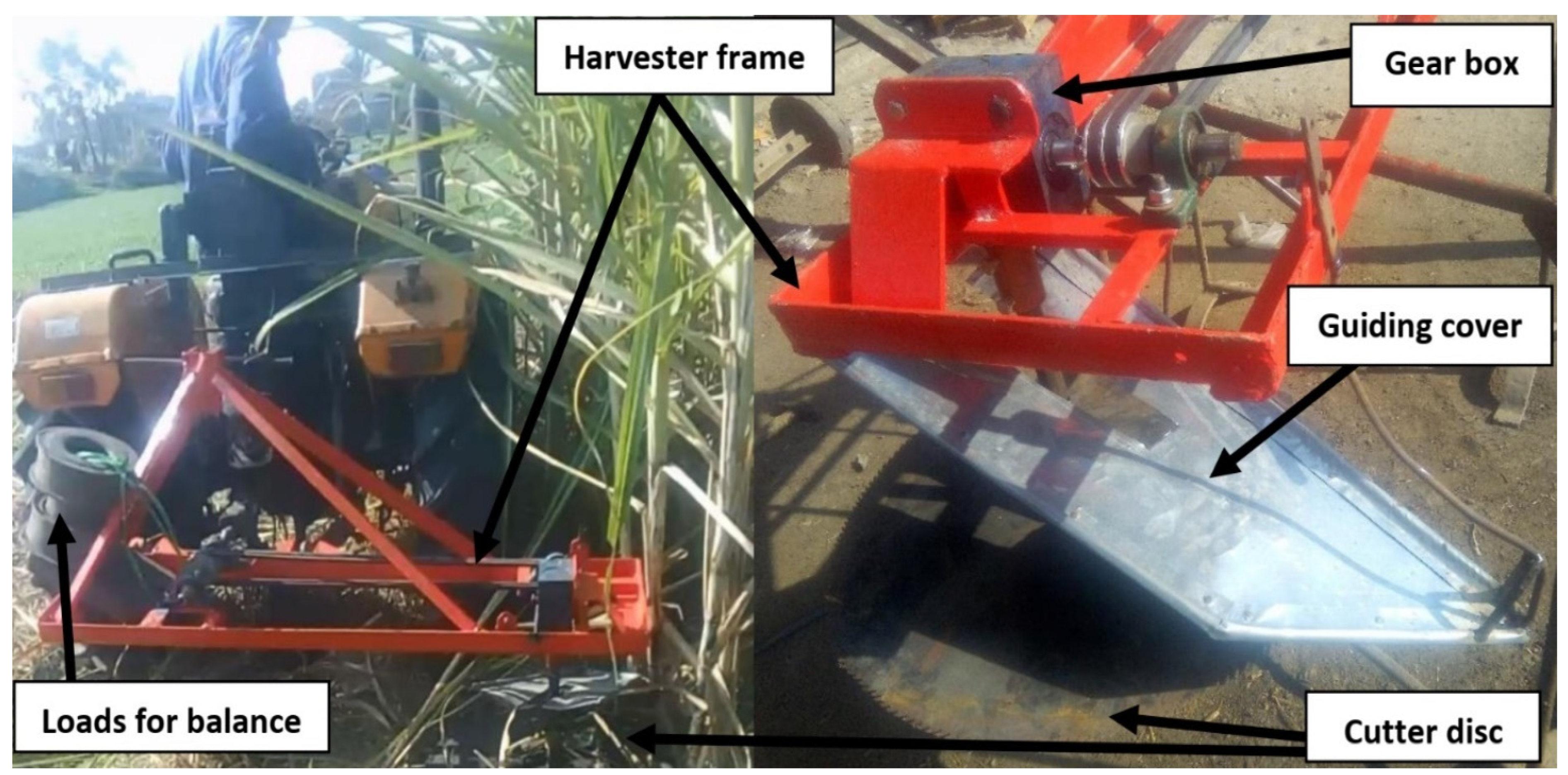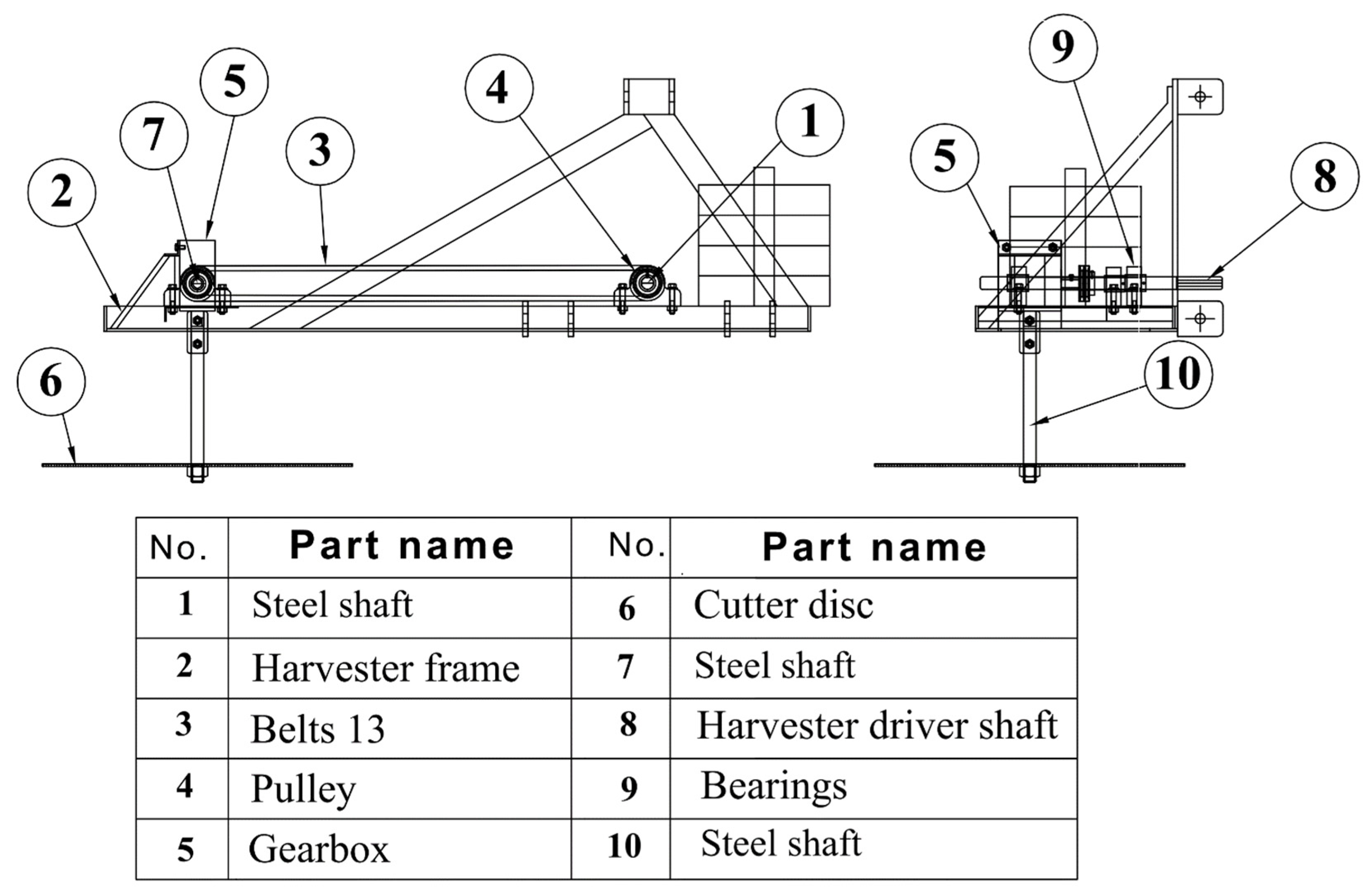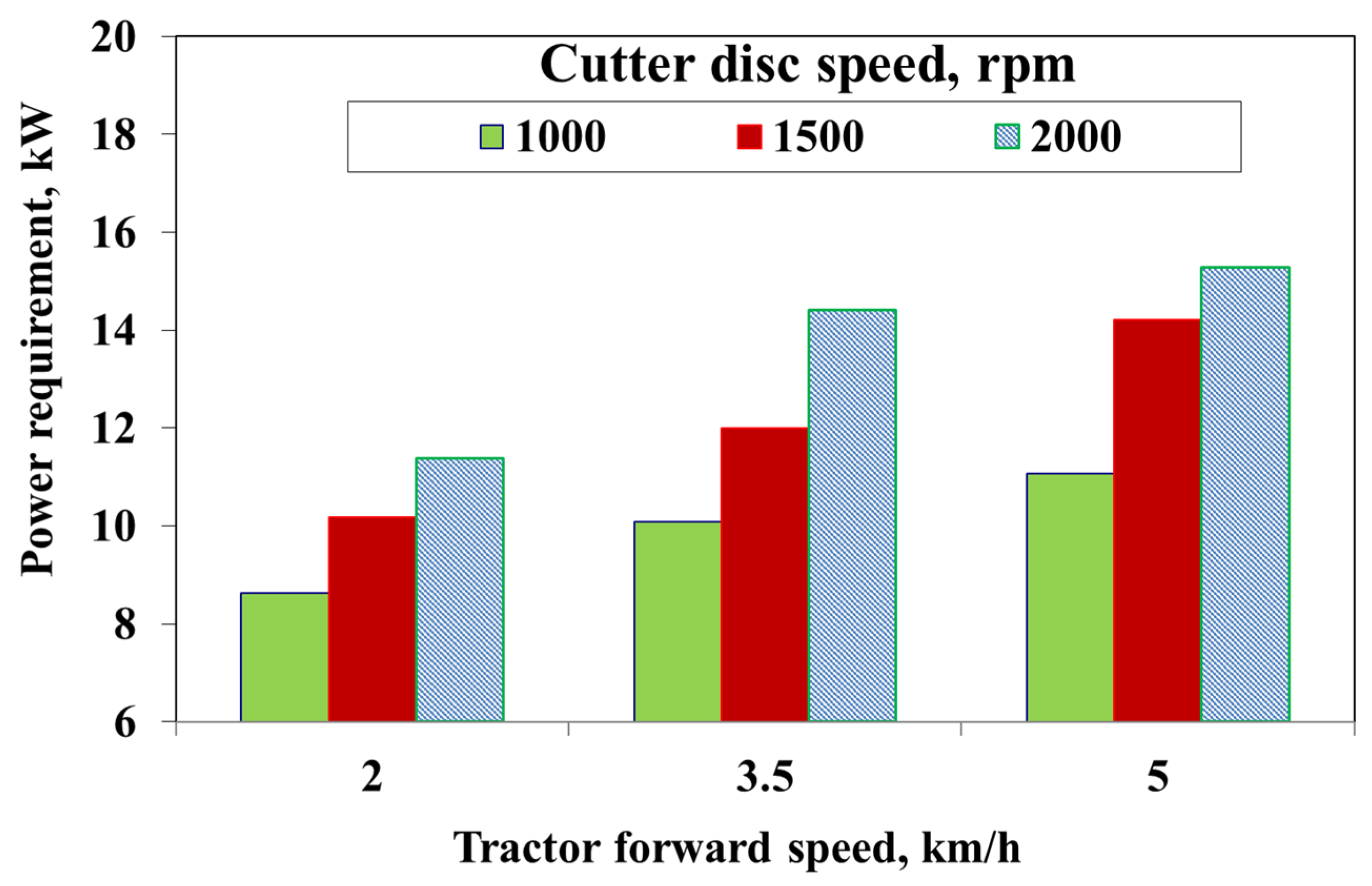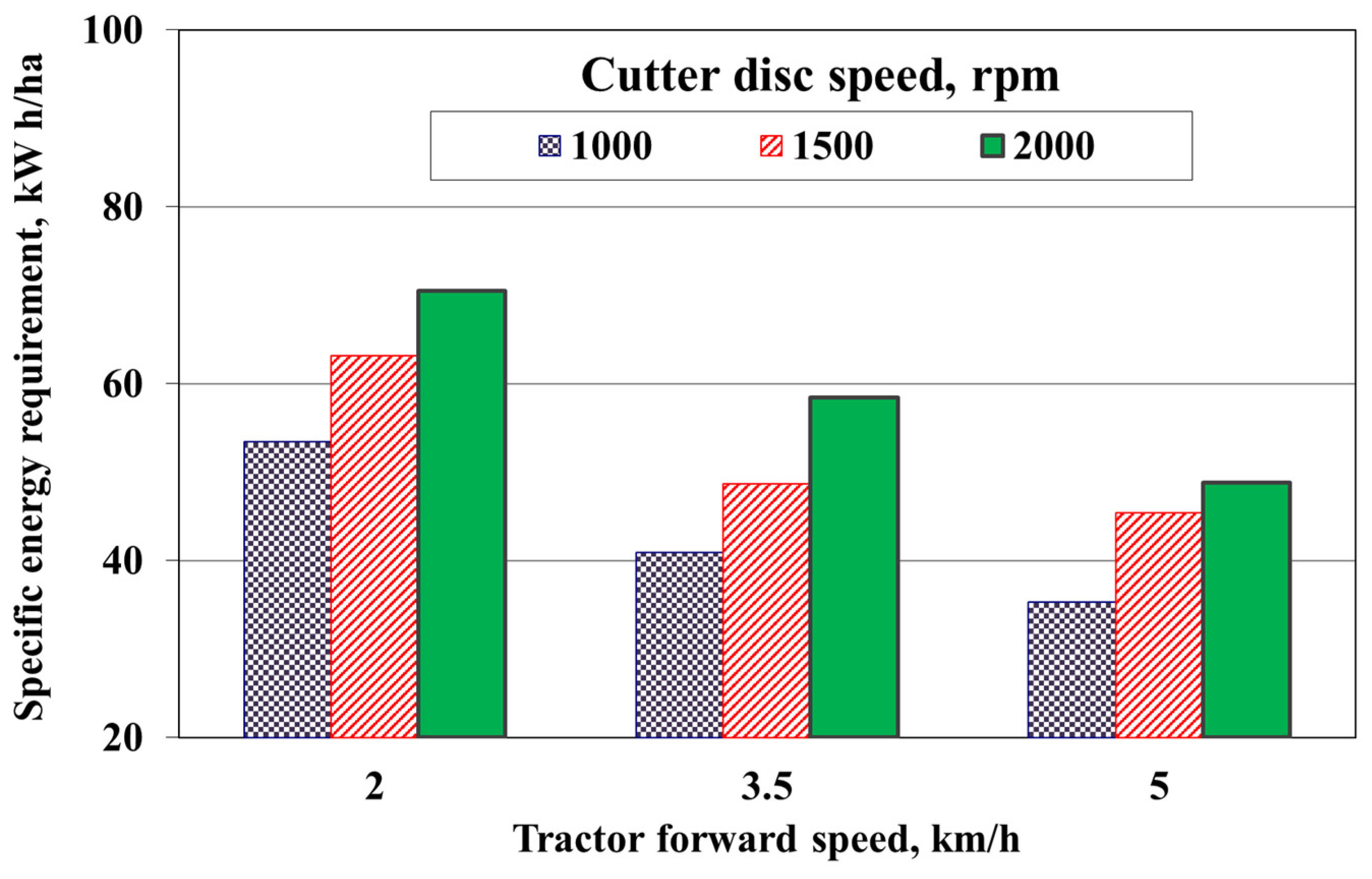Engineering and Economic Evaluation of a Prototype Fabricated for Harvesting Sugarcane
Abstract
:1. Introduction
2. Materials and Methods
2.1. Sugarcane
2.2. Tractor
2.3. Fabricated Sugarcane Harvester Prototype Specification
2.4. Experimental Conditions
2.5. Instruments
2.6. Measurements
2.7. Economic Evaluation
- The wage paid for the forces driving the machine (tractor and driver): It is represented by the hourly rental price of the tractor at the price prevailing in the experimental area, which is $9.54/h.
- Depreciation of the machine. Although the annual installment for depreciation of the machines is considered fixed costs, converting them to a share of the operating hour cost from the depreciation installment is considered as a variable cost.
- 1
- The cost of UCSS (un cutting sugarcane stalks): It is represented by the cost of manual cutting of sugarcane stalks that were not cut mechanically due to several reasons. Among these reasons, the land was not prepared properly for cultivation to suit the mechanical cutting and/or not carrying out the lashing process for the sugarcane stalks, which was carried out at least twice so that the stalks remain standing and do not fall on the ground which obstacle the mechanical cutting process. Therefore, workers are essential to cut the sugarcane stalks that were not cut mechanically, and the cost of manual cutting is calculated as follows:Average hourly wage ($0.95) × The number of operating hours for the mechanical cutting process
- 2
- The value of losses: It is the value of the remaining part of the land from the sugarcane stalks without cutting compared to the manual cutting that is directly cut at the ground level. The losses value can be estimated as follows:Losses value = The amount of losses in tons × Average price per ton ($52.99/t)The amount of wastage in tons = 1 The average remaining length of each stalk in cm × The average number of stalks in hectare × 2 Average weight of 1 cm per ton1 The average remaining length of sugarcane stalk after cutting was about 4 cm at 2.5 km h−1 forward speed and about 5 cm at 3.5 km h−1 forward speed, while it was 7 cm for 5 km h−1 forward speed.2 It was calculated by dividing the average weight of stalks in tons/the average length of stalks in cm
The Relative Importance of the Operating Cost Items of the Sugarcane Cutting Machine
3. Results and Discussion
3.1. Actual Field Capacity and Field Efficiency
3.2. Power Required and Specific Energy Requirement
4. Conclusions
Author Contributions
Funding
Institutional Review Board Statement
Informed Consent Statement
Data Availability Statement
Acknowledgments
Conflicts of Interest
References
- Statista. Statista 2019. Available online: https://www.statista.com/ (accessed on 23 January 2021).
- FAO. Production Crops All Data. FAOSTAT; FAO: Rome, Italy, 2018. [Google Scholar]
- Lai, C.Q. Mechanization of inter-tillage is the primary breakthrough link in sugarcane industry. Guang Xi Agric. Mech. 2003, 6, 33. [Google Scholar]
- Wang, R.F.; Yang, J.; Liang, Z.X.; Mo, J.L.; Gu, H.Y. Experimental optimization study on working parameters of sugarcane harvester cutter. J. Agric. Mech. Res. 2004, 4, 144–147. [Google Scholar]
- Liu, Q.T.; Ou, Y.G.; Yuan, N.X. Bending load induced failure forms of sugarcane stalks. Trans. Chin. Soc. Agric. Eng. 2004, 20, 6–9. [Google Scholar]
- Zheng, D.K.; Ou, Y.G.; Li, Z.W.; Qing, S.L.; Liu, Q.T. The parameters matching of sugarcane harvester moving rate and base cutter rev. J. Agric. Mech. Res. 2010, 6, 35–38. [Google Scholar]
- Yang, J.; Chen, G.J.; Liang, Z.X.; Mo, J.L.; Li, M. Experimental study on influencing factors of broken biennial root rate for a single base cutter of sugarcane harvester. Trans. Chin. Soc. Agric. Mach. 2007, 38, 69–74. [Google Scholar]
- Ou, Y.; Malcolm, W.; Yang, D.; Liu, Q.; Zheng, D.; Wang, M.; Liu, H. Mechanization technology: The key to sugarcane production in China. Int. J. Agric. Biol. Eng. 2013, 6, 1–27. [Google Scholar]
- Song, C.H.; Ou, Y.G. Screw and sugarcane mechanism for sugar cane up effect. J. Hunan Agric. Univ. 2004, 21, 569–571. [Google Scholar]
- Lu, Y.; Yang, J.; Liang, Z.; Mo, J.; Qiao, Y. Simulative kinematics analysis on the affecting factors of rate of broken biennial root of single base cutter of sugarcane harvester. Trans. Chin. Soc. Agric. Mach. 2008, 39, 50–55. [Google Scholar]
- Wang, X.M.; Mo, J.L. Economical efficiency analysis of the application of the sectional type sugarcane harvesting system. J. Agric. Mech. Res. 2011, 9, 49–52. [Google Scholar]
- Wang, F.; Ma, S.; Xing, H.; Bai, J.; Ma, J.; Ke, W. Basecutting energy consumption of sugarcane stools using contra-rotating basecutters. In Proceedings of the ASABE Annual International Meeting, Boston, MA, USA, 7–10 July 2019. Code 151393. [Google Scholar]
- Gupta, C.P.; Oduori, M.F. Design of the revolving knife-type sugarcane basecutter. Trans. ASAE 1992, 35, 1747–1752. [Google Scholar] [CrossRef]
- Gupta, C.P.; Lwin, L.; Kiatiwat, T. Development of a self-propelled single-axle sugarcane harvester. Appl. Eng. Agric. 1996, 12, 427–434. [Google Scholar] [CrossRef]
- Ma, S.; Scharf, P.A.; Karkee, M.; Zhang, Q. Performance Evaluation of a Chopper Harvester in Hawaii Sugarcane Fields. 2014. Available online: https://elibrary.asabe.org/abstract.asp?aid=44613 (accessed on 3 March 2022).
- Wang, F.; Zhang, W.; Di, M.; Wu, X.; Song, Z.; Xie, B.; Yang, G.; Ma, S. Sugarcane cutting quality using contra-rotating basecutters. Trans. ASABE 2019, 62, 737–747. [Google Scholar] [CrossRef]
- Salassi, M.E.; Champagne, L.P. Estimated costs of soldier and combine sugarcane harvesting systems in Louisiana. Dept of Agriculture and Agribusiness, Louisiana State University. Baton Rouge. Research Report, 1996. Available online: https://ageconsearch.umn.edu/record/31660/ (accessed on 3 March 2022).
- Mello, R.D.C.; Harris, H. Performance of basecutter of sugarcane harvester with angled and serrated blades. Rev. Bras. Eng. Agrícola Ambient. 2003, 7, 355–358. [Google Scholar] [CrossRef] [Green Version]
- Mello, R.D.C.; Harris, H. Cane Damage and Mass Losses for Conventional and Serrated Basecutter Blades. 2000. Available online: https://www.cabdirect.org/cabdirect/abstract/20002402092# (accessed on 3 March 2022).
- ASAE Standards, 2012. S358.2; Moisture Measurement—Forages. ASAE: St. Joseph, MI, USA, 2012.
- Hunt, D. Farm Power and Machinery Management, 8th ed.; Ames Iowa State University Press: Iowa City, IA, USA, 1983; p. 29. [Google Scholar]
- Ahmed, A.E.; Alam-Eldin, A.O.M. An assessment of mechanical vs manual harvesting of the sugarcane in Sudan–The case of Sennar sugar factory. J. Saudi Soc. Agric. Sci. 2015, 14, 160–166. [Google Scholar] [CrossRef] [Green Version]
- Zhang, H.; Luo, J.; Liao, P.W. Sugarcane mechanization cost analysis and the establishment of a profit evaluation model. Chin. J. Trop. Crops 2010, 10, 1669–1673. [Google Scholar]
- Bai, J.; Ma, S.; Yang, G.; Wang, F.; Xing, H.; Ke, W. Testing and analysis of the extractor of a sugarcane chopper harvester. Trans. ASABE 2020, 63, 251–257. [Google Scholar] [CrossRef]






| Sugarcane Properties | Average Values |
|---|---|
| Height of the stalk above the ground, mm | 3500 |
| Diameter of the stalk, mm | 30 |
| Mass of one sugarcane stalk, g | 1860 |
| Cut force of sugarcane stalk, N | 914 |
| Tractor Forward Speed (km/h) | Cutting Speed (rpm) | Actual Operating Time (h/ha) | Indirect Costs | Direct Costs | Total Costs ($/ha) | |||||||
|---|---|---|---|---|---|---|---|---|---|---|---|---|
| UCSS ($/ha) | Losses ($/ha) | The Driving Forces ($/ha) | The Estimated Cost of the Machine ($/ha) | |||||||||
| Value | % | Value | % | Value | % | Value | % | Value | % | |||
| 2 | 1000 | 6.19 | 5.91 | 3.82 | 87.67 | 56.7 | 59.06 | 38.2 | 1.97 | 1.28 | 154.62 | 100 |
| 2 | 1500 | 6.19 | 5.91 | 3.8 | 88.46 | 56.92 | 59.06 | 38.01 | 1.97 | 1.27 | 155.4 | 100 |
| 2 | 2000 | 6.19 | 5.91 | 3.77 | 89.71 | 57.27 | 59.06 | 37.7 | 1.97 | 1.26 | 156.65 | 100 |
| 3.5 | 1000 | 4.06 | 3.87 | 2.55 | 108.15 | 71.12 | 38.74 | 25.48 | 1.29 | 0.85 | 152.06 | 100 |
| 3.5 | 1500 | 4.06 | 3.87 | 2.52 | 109.73 | 71.42 | 38.74 | 25.22 | 1.29 | 0.84 | 153.64 | 100 |
| 3.5 | 2000 | 4.06 | 3.87 | 2.51 | 110.39 | 71.54 | 38.74 | 25.11 | 1.29 | 0.84 | 154.3 | 100 |
| 5 | 1000 | 3.19 | 3.04 | 1.65 | 150.22 | 81.32 | 30.44 | 16.48 | 1.02 | 0.55 | 184.72 | 100 |
| 5 | 1500 | 3.19 | 3.04 | 1.64 | 151.14 | 81.41 | 30.44 | 16.4 | 1.02 | 0.55 | 185.63 | 100 |
| 5 | 2000 | 3.19 | 3.04 | 1.61 | 154.87 | 81.78 | 30.44 | 16.07 | 1.02 | 0.54 | 189.37 | 100 |
| Tractor Forward Speed (km/h) | Cutting Speed (rpm) | Actual Operating Time (h/ha) | Total Mechanical Cutting Cost ($/ha) | Total Manual Cutting Cost ($/ha) | Total Benefits of Mechanical Cutting ($/ha) | Benefits/Costs (%) |
|---|---|---|---|---|---|---|
| 2 | 1000 | 6.19 | 154.62 | 267.18 | 112.56 | 72.8 |
| 2 | 1500 | 6.19 | 155.4 | 267.18 | 111.78 | 71.93 |
| 2 | 2000 | 6.19 | 156.65 | 267.18 | 110.52 | 70.55 |
| 3.5 | 1000 | 4.06 | 152.06 | 267.18 | 115.12 | 75.7 |
| 3.5 | 1500 | 4.06 | 153.64 | 267.18 | 113.54 | 73.9 |
| 3.5 | 2000 | 4.06 | 154.3 | 267.18 | 112.87 | 73.15 |
| 5 | 1000 | 3.19 | 184.72 | 267.18 | 82.45 | 44.64 |
| 5 | 1500 | 3.19 | 185.63 | 267.18 | 81.54 | 43.92 |
| 5 | 2000 | 3.19 | 189.37 | 267.18 | 77.81 | 41.09 |
| Forward Speed (km/h) | Actual Field Capacity (ha/h) | Theoretical Field Capacity (ha/h) | Field Efficiency (%) |
|---|---|---|---|
| 2 | 0.16 ± 0.016 c | 0.20 ± 0.020 c | 80.67 ± 8.067 a |
| 3.5 | 0.25 ± 0.025 b | 0.35 ± 0.035 b | 70.72 ± 7.072 b |
| 5 | 0.31 ± 0.031 a | 0.50 ± 0.050 a | 62.69 ± 6.269 c |
| ANOVA | <0.001 | <0.001 | <0.001 |
Publisher’s Note: MDPI stays neutral with regard to jurisdictional claims in published maps and institutional affiliations. |
© 2022 by the authors. Licensee MDPI, Basel, Switzerland. This article is an open access article distributed under the terms and conditions of the Creative Commons Attribution (CC BY) license (https://creativecommons.org/licenses/by/4.0/).
Share and Cite
El Shal, A.M.; Mazrou, Y.S.; El Didamony, M.I. Engineering and Economic Evaluation of a Prototype Fabricated for Harvesting Sugarcane. Designs 2022, 6, 40. https://doi.org/10.3390/designs6030040
El Shal AM, Mazrou YS, El Didamony MI. Engineering and Economic Evaluation of a Prototype Fabricated for Harvesting Sugarcane. Designs. 2022; 6(3):40. https://doi.org/10.3390/designs6030040
Chicago/Turabian StyleEl Shal, Ahmed Mohamed, Yasser Sayed Mazrou, and Mohamed Ibrahim El Didamony. 2022. "Engineering and Economic Evaluation of a Prototype Fabricated for Harvesting Sugarcane" Designs 6, no. 3: 40. https://doi.org/10.3390/designs6030040








